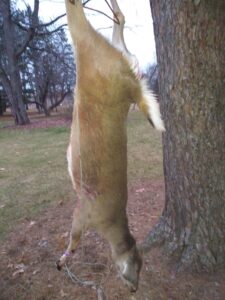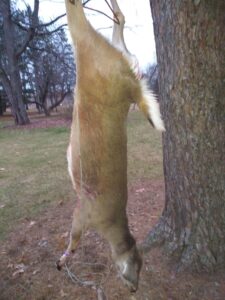Michigan’s Deer Hunting Dilemma: Too Many Deer and Not Enough Deer
By Glen Wunderlich
Charter Member Professional Outdoor Media Association (POMA)
Management of Michigan’s deer herd is rife with challenges. In our Southern zone, we have too many deer, while in the Northern reaches, the herd continues its worrisome decline.
The mandatory reporting system has given wildlife managers a necessary look into variables affecting the herd’s population and that’s a good place to start. After all, we must understand the big picture if ever we want to do our part as wildlife managers.
To effect positive change, the DNR has said that hunters, wildlife managers, landowners, foresters and others need to cooperate. Knowing the status is the first step in any successful management process.
The reported deer harvest for the entire state is down compared to last year by a total of 11 percent or almost 30,000 deer. The harvest in Michigan as of December 5, 2023 (all deer seasons) decreased compared to the autumn of 2022 by 26 percent in the Upper Peninsula, 16 percent in the northern Lower Peninsula and 7 percent in the southern Lower Peninsula.
Relative issues of deer management in the Upper Peninsula include the following:
* All 15 U.P. counties have recorded drops (all deer seasons) below last year. Declines range from 10.9 percent in Mackinac County to 40.6 percent in Gogebic, Marquette at 40.1 percent and Ontonagon 42.2 percent. Even in those three counties predicted to have good harvest numbers – Menominee, Delta and Dickinson counties – posted declines of 18.2 percent, 20.7 percent and 26 percent respectively.
* Though legal in the U.P., feeding deer spreads diseases, causes social strife, kills deer through corn and toxic reactions to high carbohydrates and likely increases deer mortality by drawing deer away from deer-wintering complexes and into poor winter habitat. Hunters could advocate for eliminating supplemental feeding of deer.
* Predators (including wolves), winter weather, habitat quality, changes to deer harvest regulations, declining hunter numbers and changes in timber harvest all play a combined role in changes to the deer population in the Upper Peninsula.
* Although the DNR predicts the deer numbers will rebound, there is one caveat: weather. Since 1996, the U.P. has experienced more than three times as many severe winters than between 1980 and 1996, along with three instances of back-to-back and two instances of three consecutive severe winters. Severe winters are those with more than 90 days with snow depth of a foot or more.
* Contrary to what some believe, wolves are not the main predator on fawns and fawn survival is what drives the deer population changes in most years. Other fawn predators include coyotes, bears and bobcats. Removing wolves from protected status would help, but one judge in Washington D.C. has ruled against allowing states to manage their wolf populations.
Issues of the Southern Lower Peninsula’s deer abundance include the following:
* The main issue is not enough does are taken.
* Hunter participation continues a downward slide statewide and has declined at an accelerated pace. The current level of youth recruitment is the lowest we have recorded since 1995. If this annual rate of decline continues, the number of youth hunters will be cut in half in less than 10 years.
* Bipartisan legislation was introduced in both chambers of the Michigan legislature that would create an elective program for Michigan school districts to host hunter and firearms safety programs within their schools.
Senate Bill 664, sponsored by Sen. Jon Bumstead (R-North Muskegon), and House Bill 5334, sponsored by Rep. Curt Vanderwall (R-Ludington) are both supported by the Michigan DNR and Department of Education. However, the legislature has adjourned for the remainder of 2023.
* Hunters need to properly identify their intended targets when attempting to take does. Although 13,181 adult does have been taken (before late antlerless season), far too many mistakes have been made. A total of 7,224 buck fawns and adult bucks having shed antlers were mistakenly killed by hunters and that doesn’t include the current late-antlerless season figures. It would behoove all hunters to use good optics before guessing.
Certainly, there are conditions beyond our control but we hunters also have much needed room for improvement.








